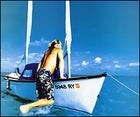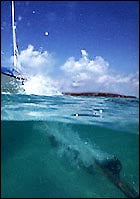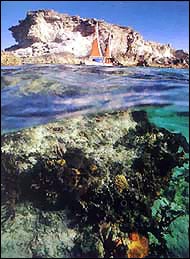WE ARE HAMMERING south to the Jumento Cays in three- to four-foot seas, and with one rail buried, our 21-foot Sea Pearl, the Arawak, lunges gamely through the waves. Winds are easterly at 10 to 12 knots, and while the weather is clear, black clouds threaten ahead. Our expedition is two people strong (or weak), and I gladly sit tight as Brian Kronemeyer, owner of Sail Exuma, trims the sails flat, checks the GPS, and mans the helm.



Three miles out with 15 to go, it’s just past sunset. As I watch Little Exuma island disappear, I try not to think about the fact that I’ve never sailed out of sight of land nor ever sailed at night. Sensing my discomfort, Brian turns to me and yells over the fury, “Don’t worry, if it blows any harder we’ll just reef the sails and open the drain plug in back! When the waves break over the bow, they’ll just wash astern and drain right out!” I give him a blank look, fumble for his cigarettes, and light up. Puffing furiously, I try to stay calm. I don’t even smoke.
I am in the Bahamas to experience an “exploratory” trip to the largely uninhabited Jumento Cays. Designed to judge an area’s suitability for new outfitted trips, exploratories are the adventure-travel industry’s version of R&D. Even though Brian has been sailing in the Bahamas for 12 years and has captained a C&C 41 around Cape Horn, he’s never been to the Jumentos, which are practically in his backyard.
Brian and I, it turns out, share a love for coastal sailing in small, open boats. We both spent our childhood summers on the water—he on Lake Michigan, I on the North Sea off Sweden’s west coast. Once, in a quixotic attempt to reach Stockholm from our home near Göteborg, my brother Max and I had sailed our family’s 21-foot Drascombe along 275 miles of Swedish coastline, raiding candy stores and bars along the way like a couple of moody, diabetic Vikings. We never made it to Stockholm.
In the same spirit, when Brian and I rendezvous at Great Exuma’s tiny airport in George Town, he pulls up in a cloud of dust and leaps from a rust-pocked truck, itching to hit the water. When I inform him that my luggage has disappeared into the black hole of Air Bahamas, he’s momentarily deflated, but we agree that with 90-degree weather, I can survive with one T-shirt, two pairs of shorts, and a toothbrush. Caught up in the Spartan ethic, we almost leave the Arawak’s tiny outboard motor as well, but our gold-toothed shuttle driver, Hadley Smith, talks us out of it. “Noo, noo, noo. Doon you do dat. Bring it, joost in caase,” he says, shaking his head.
The Atlantic Ocean, the Great Bahama Bank, the fickle rain—water rules these latitudes, the land a mere afterthought, but after 15 hours on the mariner’s equivalent of a bucking bull, I step ashore on a small, unnamed cay and kiss the ground like a pagan at Stonehenge. Seabirds peep and swoop at my head, protecting their nests, and a nearby blowhole wumps! at odd intervals. A little speck of an island, our first landfall in the Jumentos turns out to be typical for the chain. The limestone ground a few steps from the beach is yellow and diamond-sharp, textured with nooks and crannies like an English muffin. I’m amazed that the creepy, ice plant–looking flora can scratch out a life here, but much of the island is covered with low, pale greenery.
The Jumento Cays are a forgotten group of islands rimming the southern edge of the 330-mile-long Great Bahama Bank in a hundred-mile arc. Only the southernmost island of the chain, Ragged Island, is inhabited (about 40 people live there). From north to south, the islands get progressively bigger, starting as basketball court–size and growing to a square mile or two; they’re separated by stretches of water ranging from a few yards to a few miles at the southern end. Four times a day, the tide rips through these “cuts,” either dumping off the Bank or pouring in from the ocean.
What makes them so treacherous is that within three miles of the Bank’s edge, the depth changes from 25 feet to more than a mile, creating powerful tidal surges often at odds with the wind. The Arawak’s leeboards and retractable rudder enable us to sail over reefs on the protected Bank side, drawing only eight inches in a pinch, but our small size also makes us vulnerable to the confused seas. At times, sailing the Jumentos is an exercise akin to avoiding the flush of an immense toilet.
With these facts in mind, we pull the charts out of our drybags and decide to shoot for Flamingo Cay. It’s 12 miles away, but its size ensures good anchorage. Late in the day, we round a point on Flamingo’s rocky, leeward coast and come upon a beach, our beach, in a small bay framed by 50-foot limestone cliffs above a thin ribbon of sand. I set up Brian’s Day-Glo orange tent; he organizes the kitchen and anchors the Arawak offshore. While taking a swim in the blue-gray water at dusk, we spot a large male lobster hiding in a coral head not 20 yards from our tent. Ever the carnivore, Brian spears it, cleans it, and then boils it in seawater. Muddling in the dark, we chow it down along with some soupy pasta.
At midnight, a torrential downpour, a real tropical pounding, wakes me up and reminds me that we had crossed the Tropic of Cancer the night before. And that during the past 30 hours of controlled chaos, I had tackled the seas, seen a drug runner’s airplane decomposing on a beach, poked around an encampment left by Haitian refugees, and startled a majestic loggerhead turtle sunning herself in the waves.
Butter-fried Spam and eggs. Brian proudly serves me a plateful of the toasted fat ingots, and they’re not bad, really. The little curly-tailed lizards scurrying about camp, bravely nipping our toes, could not be happier with the scraps. As reckless about sun exposure (he’s the tannest man alive) as he is about diet, Brian is gloating in a kind of early retirement. At 35, he’s already built and sold a profitable direct-mail company. “My constant trips to the Bahamas were beginning to irritate my wife, so I started Sail Exuma to justify my playtime,” he says. “Now I sail and make money. Who can argue with that?”
On Brian’s eight-day standard trip up the Exuma Cays, participants sail in a flotilla, two to a Sea Pearl, with Brian leading the way in a high-powered tender. As we sip instant coffee and scrutinize the charts, we discuss alternate routes through the Jumentos. Man-of-War Cut—a brutal, three-mile stretch of open water and the only cut in the entire chain to have earned itself a name—lies five miles to the south. With the wind blowing a steady ten knots, we opt for a day sail instead of risking a crossing. The gear-free Arawak is fast and nimble on one long, high-speed reach to Man-of-War Cay, where we peek across the whitecaps to Jamaica Cay.
“There’s no way I’d take clients across this without a safety boat,” Brian says. “If anyone freaked, I could just tie off their boat and drag them across.”
Back at Flamingo, low tide has exposed deep undercuts below the cliffs, making the massif look like a giant mushroom, and we don our snorkel gear for closer inspection. We’re amazed to discover a cave that reaches some 30 yards into the rock. It’s big enough to stand up in, and in several places, sky has breached the porous limestone, lighting piles of conch shells and wave-packed sand. Brian swims off to spear dinner, and I reenter the water and continue my ogling. The reef fish, fantastic corals, and helmet conchs are so colorful they look fake.
Back at Flamingo, low tide has exposed deep undercuts below the cliffs, making the massif look like a giant mushroom, and we don our snorkel gear for closer inspection. We’re amazed to discover a cave that reaches some 30 yards into the rock. It’s big enough to stand up in, and in several places, sky has breached the porous limestone, lighting piles of conch shells and wave-packed sand. Brian swims off to spear dinner, and I reenter the water and continue my ogling. The reef fish, fantastic corals, and helmet conchs are so colorful they look fake.
Swimming back along the cliff walls, I see Brian doing an odd stroke with his spear high in the air, keeping the blood of a grouper from saturating the water. Just then I spot a six-foot lemon shark gliding my way at 20 yards. I convulsively spin around, looking to exit the water, but I’m trapped against the cliff. I turn, ready for agony, but the shark disappears like smoke into the deep blue water. I flail my way back to the beach, looking behind every few strokes, and Brian laughs, somehow pleased that I have undergone an unspoken Bahamian rite of passage. We clean the grouper together and contemplate one of life’s fundamental truths: We are food. And in giddy defiance of this law of nature, Brian chums the water’s edge with the grouper carcass.
Later that evening, four Bahamian spear fishermen we’d seen anchored nearby come to squeeze us for rum and conversation. As we sit around in the dark on coolers and rocks, they loosen up, slipping into incomprehensible Bahamian slang as they tell their stories. Much rum later, a lull in the conversation spurs one of them, Eddy, to wobble into the water and adjust the dinghy’s anchor. A wild thrashing near his feet makes him jump back, and we turn to see the dark body and dorsal fin of a good-sized shark. We all laugh riotously at Eddy’s stunned reaction, and a spirited round of shark stories gets started, each fisherman trying to outdo the other.
The next day, we sail back up the chain to Water Cay, named for its brackish spring. In stark contrast to all the rocky islands we’ve seen, most of Water Cay is sandy and powder-soft. Forty-foot bluffs run the island’s length, and we scramble up in a desperate attempt to catch a cool ocean breeze. Inventing tai chi moves, I watch a parade of ternsand seagulls preen themselves on the beach, and at one point, a big osprey eyes me as he skims by. At dusk, we eat Rice-A-Roni and take in the sunset’s delicate mix of pastels. The creamy sand, turquoise water, pink clouds, and baby-blue sky all fade into each other, soft and washed out. As the Milky Way emerges, we wave flashlights, signaling to what looks like a UFO come to abduct us.
Early the next morning, the wind is nil and the 25-mile stretch across the Bank turns into a grueling six-hour motor sail, with the sun turning my knees the color of fried Spam. We feel jubilant entering the George Town harbor, but it’s strange seeing all the big cruisers anchored safely and people lounging about. After six days, eight islands, and 120 miles of exploring, the predictability of just sitting around a harbor seems oddly pointless. We step ashore and see footprints. For once, the beach is not ours to claim.


